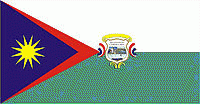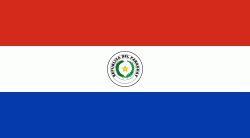Cordillera Department (Departamento de la Cordillera)
 |
 |
During the seventeenth and eighteenth centuries this area of the country was going through a serious crisis due to population bellicosity of the Indians from Chaco. The villagers from Tobatí located north of the river Pirapo then called, had to migrate south for the continue attacks by Mbaye-guaicurúes. The residents of Altos and Atyrá created their current settlements in the territory of this department.
There were also some settler farmers who were scattered in existing territories Arroyos y Esteros, 1 de Marzo, Caraguatay and Piribebuy.
Towards the end of the eighteenth century these small towns were expanding, consolidating the villages located north of the department as Arroyos y Esteros Eusebio Ayala (then called town of San Roque).
Once the Paraguayan War, began a process of founding of major towns and settlements driven by German immigrants during the government of Bernardino Caballero. Thus, in 1881 saw the founding of San Bernardino, a major tourist resort of Paraguay today
Already in the early twentieth century, in 1906, was organized legally the country dividing the territory into departments. Thus was created the department of Caraguatay, initial name of the department of Cordillera.
In the year 1945, by a decree Law No. 9484, the department received its present name: Cordillera. Finally in 1973, by Law No. 426 took place in a new territorial reorganization and country, at which consolidates the structure of the department with its current boundaries and districts.
Map - Cordillera Department (Departamento de la Cordillera)
Map
Country - Paraguay
 |
 |
| Flag of Paraguay | |
Spanish conquistadores arrived in 1524, and in 1537 established the city of Asunción, the first capital of the Governorate of the Río de la Plata. During the 17th century, Paraguay was the center of Jesuit missions, where the native Guaraní people were converted to Christianity and introduced to European culture. After the expulsion of the Jesuits from Spanish territories in 1767, Paraguay increasingly became a peripheral colony, with few urban centers and settlers. Following independence from Spain in the early 19th century, Paraguay was ruled by a series of authoritarian governments characterized by nationalist, isolationist and protectionist policies. This period ended with the disastrous Paraguayan War (1864–70), during which the country lost half its prewar population and around 25–33% of its territory to the Triple Alliance of Argentina, Brazil and Uruguay. In the 20th century, Paraguay faced another major international conflict—the Chaco War (1932–35) against Bolivia—in which it prevailed. Afterwards, the country came under a succession of military dictators, culminating in the 35-year regime of Alfredo Stroessner, which lasted until his overthrow in 1989 by an internal military coup. This marked the beginning of Paraguay's democratic era, which continues to this day.
Currency / Language
| ISO | Currency | Symbol | Significant figures |
|---|---|---|---|
| PYG | Paraguayan guaranà | ₲ | 0 |
| ISO | Language |
|---|---|
| GN | Guarani language |
| ES | Spanish language |















